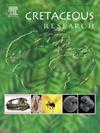利用几何形态计量学作为补充工具,重新考察了下白垩世克拉托组三个Araripeneurinae (Neuroptera, Myrmeleontidae)属的分类地位
IF 1.7
3区 地球科学
Q1 GEOLOGY
引用次数: 0
摘要
Crato组(巴西下白垩纪)保存了高度多样化的昆虫化石区系,包括Araripeneurinae(神经翅目:Myrmeleontidae) 10属,其分类长期受到模式标本有限和原始描述模糊的阻碍。本文通过结合传统形态学检查和对全型的重新描述以及翼前形状的几何形态测量分析,重新审视了三个属(cratopteryx martns - neto &; Vulcano, Caririneura martns - neto &; Vulcano)和Paracaririneura martns - neto &; Vulcano)的分类地位。我们的研究结果为这些属提供了更新和客观的诊断,在形态空间中明确了它们的独特性,并支持了nemopteroides martas - neto的新种命名。我们展示了几何形态计量学作为化石昆虫分类的补充工具的效用,为所研究属的有效性提供了支持。这一修订通过恢复和重新描述以前难以获得的全型,恢复了分类稳定性,并为今后对克拉托组Myrmeleontidae化石的系统和进化研究奠定了基础。本文章由计算机程序翻译,如有差异,请以英文原文为准。
Revisiting the taxonomic status of three Araripeneurinae (Neuroptera, Myrmeleontidae) genera from the lower Cretaceous Crato formation using geometric morphometrics as a complementary tool
The Crato Formation (Lower Cretaceous, Brazil) preserves a highly diverse fossil insect fauna, including 10 genera of Araripeneurinae (Neuroptera: Myrmeleontidae), whose taxonomy has long been hampered by limited access to type specimens and ambiguous original descriptions. Here, we revisit the taxonomic status of three genera—Cratopteryx Martins-Neto & Vulcano, Caririneura Martins-Neto & Vulcano, and Paracaririneura Martins-Neto & Vulcano—by integrating traditional morphological examination and redescriptions of holotypes with geometric morphometric analysis of forewing shape. Our results provide updated and objective diagnoses for these genera, clarify their distinctiveness based on robust morphometric separation in morphospace, and support the designation of a neotype for Cratopteryx nemopteroides Martins-Neto. We demonstrate the utility of geometric morphometrics as a complementary tool for fossil insect taxonomy, providing support for the validity of the studied genera. This revision, by restoring access and providing redescriptions of previously inaccessible holotypes, restores taxonomic stability and lays a foundation for future systematic and evolutionary studies on fossil Myrmeleontidae from the Crato Formation.
求助全文
通过发布文献求助,成功后即可免费获取论文全文。
去求助
来源期刊

Cretaceous Research
地学-地质学
CiteScore
4.10
自引率
19.00%
发文量
235
审稿时长
12 weeks
期刊介绍:
Cretaceous Research provides a forum for the rapid publication of research on all aspects of the Cretaceous Period, including its boundaries with the Jurassic and Palaeogene. Authoritative papers reporting detailed investigations of Cretaceous stratigraphy and palaeontology, studies of regional geology, and reviews of recently published books are complemented by short communications of significant new findings.
Papers submitted to Cretaceous Research should place the research in a broad context, with emphasis placed towards our better understanding of the Cretaceous, that are therefore of interest to the diverse, international readership of the journal. Full length papers that focus solely on a local theme or area will not be accepted for publication; authors of short communications are encouraged to discuss how their findings are of relevance to the Cretaceous on a broad scale.
Research Areas include:
• Regional geology
• Stratigraphy and palaeontology
• Palaeobiology
• Palaeobiogeography
• Palaeoceanography
• Palaeoclimatology
• Evolutionary Palaeoecology
• Geochronology
• Global events.
 求助内容:
求助内容: 应助结果提醒方式:
应助结果提醒方式:


